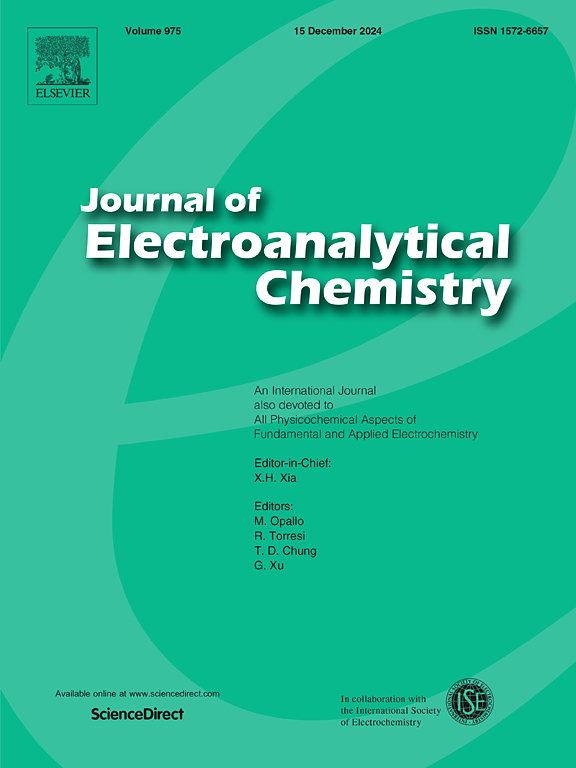MoS2 bulk layer-carbon composite for hydrogen evolution reaction: Experimental and theoretical DFT insights
IF 4.1
3区 化学
Q1 CHEMISTRY, ANALYTICAL
引用次数: 0
Abstract
Monolayer or few-layer of MoS2 or their composites serves as an excellent electrocatalysts for HER. However, large-scale production requires a cost-effective and simple processes. When a bulk layer is used as an electrocatalyst, scaling up becomes easier and offers significant advantage for the catalysis industry. Hence present study explores the synthesis of bulk MoS2 and carbon composites of molybdenum disulphide (MoS2-C) powder for its potential application in HER through experimental and theoretical DFT approaches. Wet-chemical method was conducted for synthesis in a basic medium and Raman spectroscopy identified MoS2 bulk layer, having characteristic peaks at 381 cm−1 (E12g) and 410 cm−1 (A1g) and separation between two peaks k value of 29 cm−1. The electrocatalytic HER performance of bulk MoS2-C composite exhibited the highest efficiency, achieving a low overpotential of 470 mV @10 mA/cm2 of current density. To further understand the position and nature of hydrogen adsorption on samples, the DFT was explored. The findings of the hydrogen adsorption Gibbs free energy calculation show that the hydrogen adsorption on the position-2 (distance 2.21 Å) sulphur site is the most stable adsorption configuration for HER activity, compared to a position-1 site of carbon composite MoS2. This occurs due to the high density of electrons near fermi level which is helpful for hydrogen adsorption. Moreover, the present work will stimulate the researcher to enhance HER efficiency for other transition metal dichalcogenides (TMD viz. WS2, VS2) bulk layers.

二硫化钼体层-碳复合材料的析氢反应:实验和理论的DFT见解
单层或多层二硫化钼或其复合材料是一种优良的HER电催化剂。然而,大规模生产需要成本效益和简单的工艺。当散装层用作电催化剂时,扩大规模变得更容易,并为催化行业提供了显着的优势。因此,本研究通过实验和理论的DFT方法探讨了二硫化钼(MoS2- c)粉末的块状二硫化钼和碳复合材料在HER中的潜在应用。在基本介质中采用湿化学方法合成,拉曼光谱鉴定出MoS2体层,特征峰在381 cm−1 (E12g)和410 cm−1 (A1g),两峰之间的分离∆k值为29 cm−1。块体MoS2-C复合材料的电催化HER效率最高,电流密度为470 mV @10 mA/cm2,过电位较低。为了进一步了解氢在样品上吸附的位置和性质,对DFT进行了探索。氢气吸附的吉布斯自由能计算结果表明,与碳复合材料MoS2的1位吸附相比,氢在2位(距离2.21 Å)硫基上的吸附是最稳定的HER活性吸附构型。这是由于费米能级附近的电子密度高,有利于氢的吸附。此外,本工作将激励研究人员提高其他过渡金属二硫族化合物(TMD,即WS2, VS2)体层的HER效率。
本文章由计算机程序翻译,如有差异,请以英文原文为准。
求助全文
约1分钟内获得全文
求助全文
来源期刊
CiteScore
7.80
自引率
6.70%
发文量
912
审稿时长
2.4 months
期刊介绍:
The Journal of Electroanalytical Chemistry is the foremost international journal devoted to the interdisciplinary subject of electrochemistry in all its aspects, theoretical as well as applied.
Electrochemistry is a wide ranging area that is in a state of continuous evolution. Rather than compiling a long list of topics covered by the Journal, the editors would like to draw particular attention to the key issues of novelty, topicality and quality. Papers should present new and interesting electrochemical science in a way that is accessible to the reader. The presentation and discussion should be at a level that is consistent with the international status of the Journal. Reports describing the application of well-established techniques to problems that are essentially technical will not be accepted. Similarly, papers that report observations but fail to provide adequate interpretation will be rejected by the Editors. Papers dealing with technical electrochemistry should be submitted to other specialist journals unless the authors can show that their work provides substantially new insights into electrochemical processes.

 求助内容:
求助内容: 应助结果提醒方式:
应助结果提醒方式:


